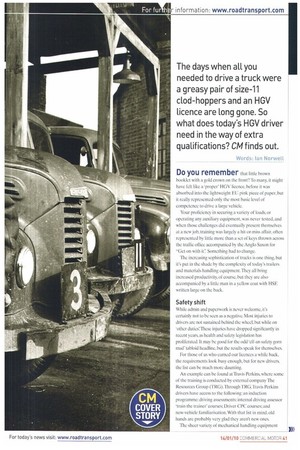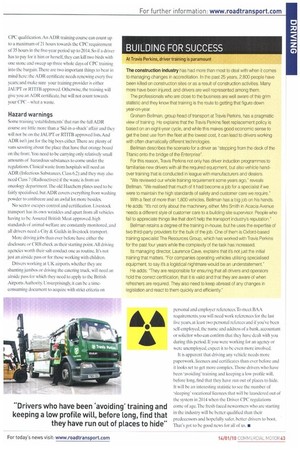The days when all you needed to drive a truck
Page 41

Page 42

Page 43

If you've noticed an error in this article please click here to report it so we can fix it.
were a greasy pair of size-11 clod-hoppers and an HGV licence are long gone. So what does today's HGV driver need in the way of extra qualifications? CM finds out.
Words: Ian Norwett Do you remember that little brown booklet with a gold crown on the front? To many, it might have felt like a 'proper' HGV licence, before it was absorbed into the lightweight EU pink piece of paper, but it really represented only the most basic level of competence to drive a large vehicle.
Your proficiency in securing a variety of loads, or operating any auxiliary equipment, was never tested, and when those challenges did eventually present themselves at a new job, training was largely a hit-or-miss affair, often represented by little more than a set of keys thrown across the traffic office accompanied by the Anglo Saxon for 'Get on with it': Something had to change.
The increasing sophistication of trucks is one thing, but it's put in the shade by the complexity of today's trailers and materials handling equipment. They all bring increased productivity, of course, but they are also accompanied by a tittle man in a yellow coat with HSE written large on the back.
Safety shift
While admin and paperwork is never welcome, it's certainly not to be seen as a negative. Most injuries to drivers are not sustained behind the wheel, but while on 'other duties !These injuries have dropped significantly in recent years, as health and safety legislation has proliferated. It may be good for the odd 'elf-an-safety gorn mad' tabloid headline, but the results speak for themselves.
For those of us who earned our licences a while back, the requirements look busy enough, but for new drivers, the list can be much more daunting.
An example can be found at Travis Perkins, where some of the training is conducted by external company The Resources Group (TRG-).Through TRG,Travis Perkins drivers have access to the following: an induction programme; driving assessments; internal driving assessor 'train the trainer' courses; Driver CPC: courses; and new-vehicle familiarisation. With that list in mind, old hands are probably very glad they aren't new ones.
The sheer variety of mechanical handling equipment
that today's multi-tasking drivers could be expected to use safely is bewildering — and all of it carries As own specialist training.
Apart from the obvious Moffetts. truck-mounted cranes and various classes of forklift, there are loaders, pickers, reach-trucks, pallet trucks, straddle trucks, scissor and cherry pickers, overhead pendant and gantry cranes, side loaders, combilifts and plenty more.
If a driver operates a lift-truck as part of their day-today role, or drives a vehicle with a transportable lift-truck (Moffett) attached, they will be required to undergo operator training to obtain their certificate as well as refreshing this training on a threeto five-year basis. This will result in a pocket permit detailing the accreditation body, for instance the Independent Raining Standards Scheme and Register (ITSSAR). which must be carried. The same goes for vehicles with loader cranes attached. This permit must also be from an appropriate accreditation body such as the Association of Lorry Loader Manufacturers and Importers. or ITSSAR.
Qualifications Many construction sites now demand that drivers hold, at a minimum, the Construction Skills Certification Scheme Health & Safety Test card, preferably the CPCS Card, which means that they have not only undergone the health and safety test, but also an NVQ in the particular piece of equipment they will be operating, be it a crane or lift-truck or some other piece of equipment. Regulations are getting tougher all the time.
Even if you are using no specific equipment, it is necessary for anyone who works at height to undergo specific health and safety training.
According to the Work at Height Regulations 2005, at height means -where, if measures required by these regulations were not taken, a person could fall a distance liable to cause personal injuiy:It's a brave site manager who puts a tape measure against that one. And for some time now, many ladders have been replaced with miniscaffold towers, and yes, training is required.
So much for Bob the Builder. For any individual driver who gets tangled up in any of this, the costs could be substantial if they are self-employed. Generally, the responsibility and the financial burden lands on employers who need to keep their drivers' skills up to date, so they will pick up the tab. If a driver is out of work and needs to beef up his or her qualifications to make themselves more employable, they'll need to budget between £60 and £120 a day depending on the course they choose."Ibe ADR (hazardous goods) certificate is a good example of a popular add-on.
Here's a real example of the trail that a driver encountered when they walked into a driving agency with only the basic licence and digicard. The agency supplied drivers to a local MoD depot. It required the usual proof of ID as well as the basic security and criminal record checks that are provided by Disclosure Scotland (The Criminal Records Bureau does the same in England and Wales), at a cost of £23. Disclosure Scotland issues certificates — known as 'disclosures' — which give details of an individual's criminal convictions, or state that they have none. Enhanced disclosures, where appropriate, also contain information held by police forces and government bodies.
It was then apparent that driving work with the MoD would be very limited unless an ADR certificate was gained. If a trailer had one hazardous item on board — it could be only a lkg pack of firelighter briquettes — it needed an ADR-qualified driver to move it. The agency's chosen training provider charged £608 for a five-day course to include explosives, but exclude tankers.
The most common ADR course is 'Core. Packages and classes 2-9 excluding 7: Most people don't need class 1 (Explosives) or class 7, (Radioactives).
Whenever a driver undergoes any training from now on, they should always ask if it counts towards their Driver CPC qualification. An ADR training course can count up to a maximum of 21 hours towards the CPC requirement of 35 hours in the five-year period up to 2014. So if a driver has to pay for it him or herself, they can kill two birds with one stone and sweep up three whole days of CPC training into the bargain. There are two important things to bear in mind here: the ADR certificate needs renewing every five years; and make sure your training provider is either JAUPT or RTITB approved. Otherwise, the training will give you an ADR certificate, but will not count towards your CPC — what a waste.
Hazard warnings
Some training 'establishments' that run the full ADR course are little more than a 'Ski-in-a-shack' affair and they will not he on the JAUPT or RTITB approved lists. And ADR isn't just for the big boys either. There are plenty of vans scooting about the place that have that orange board on the front. You need to be carrying only relatively small amounts of hazardous substances to come under the regulations. Clinical waste from hospitals will need an ADR (Infectious Substances, Class 6.2) and they may also need Class? (Raclioactives) if the waste is from an oncology department. The old Ilazchem plates used to be fairly specialised, but ADR covers everything from washing powder to antifreeze and an awful lot more besides.
No sector escapes control and certification. Livestock transport has its own wrinkles and apart from all vehicles having to be Assured British Meat approved, high standards of animal welfare are constantly monitored, and all drivers need a City & Guilds in livestock transport.
More driving jobs than ever before have either the disclosure or CRB check as their starting point. All driving agencies worth their salt conduct one as routine. It's not just an airside pass or for those working with children.
Drivers working at UK airports, whether they are shunting jumbos or driving the catering truck. will need an airside pass for which they need to apply to the British Airports Authority. Unsurprisingly, it can be a timeconsuming document to acquire with strict criteria on personal and employer references. To meet BAA requirements, you will need work references for the last five years, at least two personal referees and if you've been self-employed, the name and address of a bank, accountant or solicitor who can confirm that they have dealt with you during this period. If you were working for an agency or were unemployed, expect it to be even more involved.
It is apparent that driving any vehicle needs more paperwork, licences and certificates than ever before and it looks set to get more complex. Those drivers who have been 'avoiding' training and keeping a low profile will, before long, find that they have run out of places to hide. It will be an interesting statistic to see the number of 'sleeping' vocational licences that will be laundered out of the system in 2014 when the Driver CPC regulations come of age. The fresh-faced newcomers who are starting in the industry will be better qualified than their predecessors and hopefully safer, better drivers to boot. That's got to be good news for all of us. •




































































































































